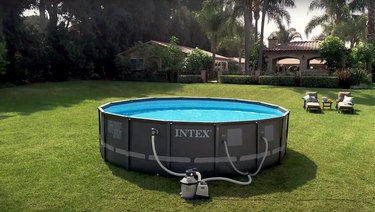During those hot summer days, there's nothing better than relaxing in your backyard pool. So, let's say you've set up your above-ground pool, filled it with water — now what? Before you jump in the water, there are a few steps you must take to ensure that your pool is safe for swimmers. To help you figure out exactly how to do so, we reached out to pool care experts and the Centers for Disease Control and Prevention (CDC) for advice.
Meet the Experts
- Michele Hlavsa, RN, MPH, the head of the CDC's Healthy Swimming Program
- Dan Bailey, president of WikiLawn, a lawn and garden resource
- Matt Giovanisci, founder of Swim University, a pool and spa care resource
Video of the Day
1. Learn Pool Safety
"Even before somebody considers installing a backyard pool, hooking up the filter, and filling it [with water], they need to read up and learn about how to prevent drowning and pool chemical injuries," Michele Hlavsa, RN, MPH, the head of the CDC's Healthy Swimming Program, tells Hunker. "We know that drowning is the leading cause of injury-related deaths in children one to four years old. A lot of the drowning in this age group occurs in pools, so backyard pool owners need to make sure everyone learns how to swim. Parents or guardians need to make sure they're providing close supervision within arm's reach of the child and that they're not engrossed in their smartphone."
Video of the Day
Hlavsa specifically recommends that pool owners consider installing window locks and alarms, along with fencing around the pool, to make sure that children don't have easy access to this area. The same goes for pool chemicals.
"There [are around] 4,500 emergency department visits each year for pool chemical injuries, mostly splashes to the eye or onto the skin," Hlavsa says. "So we want to make sure we're reading labels on pool chemicals and following instructions. We want to make sure we're wearing safety equipment, such as masks or goggles, and making sure we're securing these chemicals away from children and pets. About a third to a half of pool chemical injuries occur in children 17 years of age or younger."
To help with this, you'll want to post aquatic safety signs around the pool, which you can find in your pool's manual or at a local pool store. For pool chemicals, the CDC provides safety posters.
2. Turn on the Filter
Once you've got all the items on the safety checklist marked off, it's time to get started. Turn on the filter, following the pool manufacturer's instructions, and ensure that it's working properly. You want to confirm that it's completely set up and not leaking.
If you notice any issues with your filter, call the pool manufacturer or pool store where you purchased the pool. They should be able to help you troubleshoot any problems.
3. Vacuum and Skim off Debris
While you were installing and filling the pool, it's likely that debris entered the inside of the pool. "You need to vacuum the bottom of [the pool] to get up any lingering debris that could damage the pool liner," Dan Bailey, president of WikiLawn, a lawn and garden resource, tells Hunker. He adds that you should also use your pool skimmer (like this one from Evob) to remove any debris that's floating in or on top of the water.
4. Test the Water — Twice
"You can either test the water yourself or you could bring it into a local company to get it tested, but you're going to want to pick up some test strips or a test kit," Matt Giovanisci, founder of Swim University, a pool and spa care resource, tells Hunker. You'll want to ensure that the water is chemically balanced, while carefully following the pool manufacturer's instructions, before allowing anyone to swim.
"Check the chlorine and the pH, or the bromine," Hlavsa says, when asked about what you should focus on after their above-ground pool is filled. "The chlorine is what kills or inactivates the germs in the water, and the CDC recommends one to ten parts per million. We recommend that backyard pool owners check the chlorine at least twice a day, if not more often when there's heavy use."
As for the pH, the CDC recommends that it be between 7.2 to 7.8, which is the range that will keep swimmers comfortable in the water. "If the pH drops below 7.2, the chlorine is more effective at killing or inactivating germs, but the swimmers can become increasingly uncomfortable in the water ... and the equipment can start corroding," Hlavsa states. If the pH goes above 7.8, the chlorine won't be as effective at killing germs and swimmers can become uncomfortable.
How Long After Putting Chemicals In My Pool Can I Swim?
Giovanisci says that you’ll want to allow the chemicals to circulate for a few hours and then test the water again. Once everything is balanced, then it’s safe for swimming.
